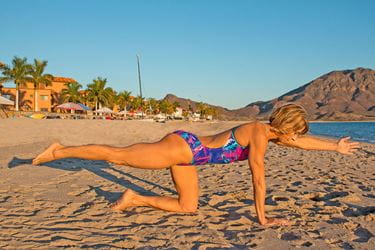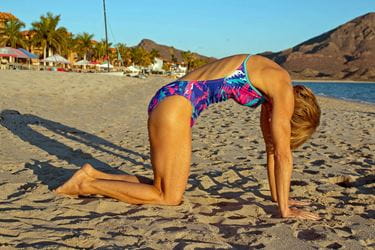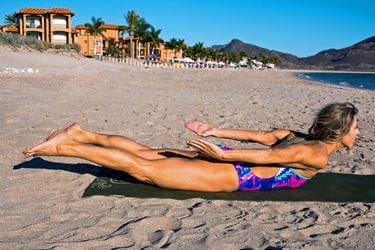Three Yoga Poses for Spinal Health
Try doing the bird dog, cat and cow, and locust to help your spine
The column of vertebral bodies and arches that make up your spine are key to comfortable movement in and out of the water. A healthy spine is both flexible and stable, with a comfortable balance of what the sage Patanjali describes in his book of the yoga sutras as steadiness (sthira) and ease (sukha).
The 24 articulating vertebrae of the spine are supported by cartilaginous discs, capsular joints, and spinal ligaments. Five lumbar vertebrae (L1-L5) sit in the base of the spine above the sacrum and the tailbone, which consist of fused vertebrae that don’t flex or bend. Stacked above the lumbar vertebrae sit 12 thoracic vertebrae (T1-T12). Seven vertebrae make up the cervical spine (C1-C7) or neck area. Yoga postures, or asanas, can facilitate a healthy cervical, thoracic, and lumbar spine—one that freely flexes forward and laterally, extends, and rotates within normal limits.
The bird dog, cat and cow, and locust poses work in different ways to facilitate movement and stability in the spine. For best results, perform these asanas after a series of sun salutations or a bout of aerobic activity when your muscles are warm and more flexible. The “no pain, no gain” philosophy should be discarded when practicing yoga.
Breath, or pranayama, is the most vital component of yoga and should always lead the way when moving into and sustaining the postures. Breathe long and slow and smooth, feeling expansion in your abdomen, rib cage, and chest. Notice the subtleties of your breath. Taking deep breaths will help you become more aware of breath quality and how proper alignment enables you to take longer, more restorative breaths.
Consult with a physician before doing these poses. This is imperative if you recently injured your back or have had spinal surgery.
Bird Dog (Dandayamna Bharmanasana)
Benefits
Many physical therapy programs prescribe this exercise to patients experiencing back problems, with good reason. The bird dog strengthens the multifidus muscles—muscle fibers along the back of your spine spanning several vertebral segments. Researchers and physicians have established that these muscles play a key role in stabilizing the lower back and pelvis and maintaining a healthy back.
along the back of your spine spanning several vertebral segments. Researchers and physicians have established that these muscles play a key role in stabilizing the lower back and pelvis and maintaining a healthy back.
Without muscular support, the spine is fragile. That’s one reason why back injuries are so common. Many people engage in lifting and bending and other activities that place undue stress on their spine, while few properly train the appropriate muscles to endure these activities. Performing the bird dog regularly will strengthen the multifidus muscles, help properly align the spinal vertebrae, and enable your spine to move more freely without injury. This exercise will also strengthen other deep core muscles and improve balance.
How to Execute
Start on your hands and knees with your hands shoulder-width apart (fingers spread) and your knees hip-width apart. Start with a neutral spine, keeping your head in alignment with your spine and your gaze toward your mat. Slowly extend your right leg back—gently flexing your foot—and your left arm forward, thumb facing the sky. Reach your hand forward a little more, lengthening through your spine. Your raised heel should be no higher than the level of your pelvis to prevent any uncomfortable arching of the back (and loss of core control). Lift up slightly in your belly and level your pelvis if it feels as though it has “tipped.” Roll the supporting shoulder back and away from your ear. Maintain this position for five to 10 breaths. Sit back in child’s pose for a few breaths to relax before switching sides. Another option is to inhale on the extension, exhale as you lower your limbs, and continue with this movement pattern, alternating sides, until you’ve done eight to 12 repetitions on each side.
Cat and Cow (Marjaryasana and Bitilasana)
Benefits
Cat and cow will gently open and close the spaces between the vertebrae, facilitating more comfortable movement of the spine. It will also improve flexibility of the shoulders, abdomen, and hips. This asana may relieve menstrual cramps, lower back pain, and even pain associated with sciatica. Cat and cow awakens the second chakra, the swadhisthana chakra, which can enhance creativity and concentration and reduce feelings of depression.
and hips. This asana may relieve menstrual cramps, lower back pain, and even pain associated with sciatica. Cat and cow awakens the second chakra, the swadhisthana chakra, which can enhance creativity and concentration and reduce feelings of depression.
How to Execute
Start on your hands and knees with your hands below your shoulders and shoulder-width apart and your knees under your hips and hip-width apart. The tops of your feet should be on your mat. Think about initiating movements from your tailbone as if there’s an energy current moving through your spine. This will help your movements feel more fluid and facilitate awakening of your body’s chakras, or energy centers.
To move into cat, slowly begin to tuck your hips and round your spine up toward the sky as you drop your gaze toward your navel. To move into cow, slowly lower your belly button toward the floor and raise your head and hips. Match your movement with your breath, transitioning from cat to cow in a slow, fluid manner. Perform five to 10 times.
Locust (Salabasana)
Benefits
The locust strengthens the erector spinae muscles, gluteals, and hamstrings, improving posture and back health. It also stretches the shoulders and chest and prepares the body for deeper backbends.
deeper backbends.
How to Execute
Start on your belly with your arms at your sides, forehead on your mat, palms facing up. On your next exhale, gently squeeze your legs together and then inhale, raising your torso, arms, and lower legs up off the ground. Imagine pressing your pelvis into the floor. This will keep your lower back stable as you gradually move into this backbend. Reach your fingers back, palms up, slowly lifting your legs and torso up a little farther if you don’t feel discomfort in your lower back. Your arms should be parallel to the floor, fingertips reaching back, your upper arms pushing upward as if they’re supporting weight. Your hands may rest alongside your body, rather than being elevated, if you feel pain in your lower back. Keep your gaze toward the front or slightly down and keep your shoulders relaxed and away from your ears, neck long, jaw muscles relaxed. Imagine lengthening your body from the toes to the crown of your head. Stay here for five to 10 breaths.
To enhance stretching in your shoulders and chest, interlace your fingers behind your back, lengthen your arms, squeeze your shoulder blades together, and open the outsides of your shoulders.
Categories:
- Technique and Training
















